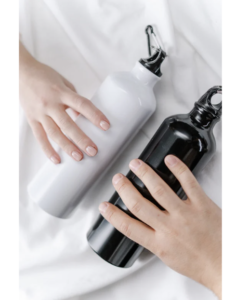
Installing a reverse osmosis for drinking water vs buying bottled water
July 18, 2022Is installing a reverse osmosis water filter worth it?
Reverse osmosis water is gaining in popularity, but is getting a water filtration system installed in your home really worth it? Why not just drink bottled water? Today we are going to break down all the benefits and potential downfalls of getting your home set up on a reverse osmosis water filtration system. We will also answer the top questions about how having a reverse osmosis filtration system installed in your home may be a much better time, health and cost efficient option.
What is reverse osmosis water & filtration?
Reverse osmosis is a type of water purification and filtration that removes many of the natural and synthetic minerals, additives and contaminants that groundwater collects before it makes it through your tap water system.
The RO process provides water that tastes equally as pure and refreshing as bottled water, and has many more advantages, which we will discuss shortly. Ro removes salt and fluoride from your tap water which is why it is one of the most popular choices for kitchen sinks and water sources.
Other main reasons people choose reverse osmosis water is because it uses a carbon filtration technology that removes chlorines and other contaminants including arsenic, pesticides, herbicides and more.
The modern day RO systems have come a long way not only in process and effectiveness, but also in convenience. These days it is commonplace to see filtration systems in homes because they fit neatly under your sink or in a cabinet.
Installation is quick, and relatively inexpensive when done by a trusted professional.
How does RO filtration work?
Reverse osmosis filtration devices work by using either a 3, 4 or 5 step filtration process. Every reverse osmosis water filtration system includes pre-filters, post-filters, and a membrane. These are labeled in accordance with the part of the process in which they are used.
The 3 main parts included in each RO filtration system:
- Sediment Filter – Used for reducing dirt, dust, sediment & rust
- Carbon Filter – Used to reduce contaminants that cause bad taste & odor (chlorine, VOCs, chemicals)
- Semi-permeable Membrane – Used to remove TDS/ total dissolved solids (can remove up to 98%)
Now that you know the parts that make up the RO filtration system, you may be wondering “Exactly how do these parts filter the water? The process is really quite simple once you understand the order of operations.
- Pre-filtration Part A: The water enters the reverse osmosis system and makes its way through the Sediment Filter. In this phase, the particles (dirt, dust, rust and anything that could clog or damage the membrane) are filtered out and reduced.
- Pre-filtration Part B: The water then moves through the second filter which is the Carbon Filter. Here the chemicals are reduced and taste starts to improve.
- Water enters the RO membrane where microscopic particles and residues are dissolved.
- Water moves into your RO filtered water storage tank. Here the water is stored until use, and the filtration system is paused until water levels drop. This is an energy & water saving mechanism.
- The water passes through the final filter as it comes out for use. This is the system’s post filter process, and makes sure your water is the best tasting and quality possible.
Which is better, reverse osmosis or bottled water?
There is much debate about whether RO water is better than bottled water or not. While you may not notice much difference in taste, we believe there are some major benefits to reverse osmosis in home filtration over bottled water.
While bottled water may seem convenient, it often ends up being more of a hassle than having a filtration system at home. With a little planning, you can save a lot of time and money, not to mention make a huge difference in reducing waste for our environment.
The other main reason bottled water isn’t as good of an option is because oftentimes the plastic bottle leeches harmful chemicals into the expensive “purified” water you’re drinking. These are exaggerated when bottles are left in the sun or exposed to excessive heat.
Single use plastic (water bottles) are one of the biggest contributors to our Earth’s pollution. The water bottling process releases over 2.5 million tons of carbon dioxide into the atmosphere per year. After use of these plastics, over half of these plastics end up submerged under the ocean surface creating micro-plastics that we are unable to remove. This results in killing more than 1.1 million marine creatures each year.

What are the advantages and benefits of reverse osmosis water?
Pros of in home reverse osmosis filtration:
- Fill your bottle for on the go
- Unlimited water at home for drinking
- Ro water for cooking
- Use for refrigerator hook up
- Use for ice
- Water your plants and fruit/vegetable garden
- Save tons money from not buying bottled water
- Reduce tons of plastic waste
- Ro water health benefits are numerous!
What are the disadvantages of RO water?
Cons of reverse osmosis water:
- Slightly more water waste potential
- Lack of essential minerals that can sometimes be received by water
Is reverse osmosis water good for you?
While some studies point to the negative potentials of RO water, the evidence is clear that the good far outweighs the bad. By using a reverse osmosis filtration system, you are removing most of the dangerous contaminants and sediments that other water has.
Your best water source is a personal choice that should be made backed by research on your specific needs. If your goal is to reduce harmful natural and synthetic substances from your water, the RO may be a great solution for you.
What are the environmental impacts of RO water?
There is no doubt that anything we can do to reduce plastic will result in a cleaner, healthier planet. That being said, you may be wondering what other effects RO water has on the environment, and if it is the superior choice still.
Reverse osmosis is one of the greenest solutions for industrial wastewater. Ro filtration processes also have a much better efficiency for properly disposing of captured particles and contaminants from the main water feed.
While there is some additional water waste not typically found in other processes, it is minimal in comparison to the positive effects of choosing RO water.
Is reverse osmosis the same as filtered water?
Reverse osmosis water is filtered water. There are many different filtration processes, each with slightly to significantly different results. Ro water is known for being among the highest levels of filtration from salt, sediment and contaminations available.
For more information on other water filtration options, make sure to come back to our blog in the upcoming months! You can also find more information on water filtration systems here.
Should I get a reverse osmosis system? Is it worth it?
Hopefully you now have a better understanding of reverse osmosis water and whether or not it’s right for you. If you still have lingering concerns or questions about if it is really worth having an RO filtration system installed in your home or not, then give us a call (717) 768-3276 today , or contact us here so we can help answer any questions you may have. Our experts are happy to provide detailed information on what the process entails, and what you can expect should you decide to move forward.
Do we think it’s worth it to bring RO water into your home? Yes!
As a family business, we only offer the services we truly believe in. We decided to include reverse osmosis water filtration services because we can see the immense benefits and continue to get reviews of how much our loyal customers love it!